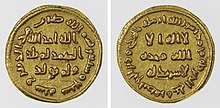Our website is made possible by displaying online advertisements to our visitors.
Please consider supporting us by disabling your ad blocker.
Gold dinar
This article has multiple issues. Please help improve it or discuss these issues on the talk page. (Learn how and when to remove these messages)
|




The gold dinar (Arabic: ﺩﻳﻨﺎﺭ ذهب) is an Islamic medieval gold coin first issued in AH 77 (696–697 CE) by Caliph Abd al-Malik ibn Marwan. The weight of the dinar is 1 mithqal (4.25 grams or 0.137 troy ounces).
The word dinar comes from the Latin word denarius, which was a silver coin. The name "dinar" is also used for Sasanid, Kushan, and Kidarite gold coins, though it is not known what the contemporary name was.
The first dinars were issued by the Umayyad Caliphate. Under the dynasties that followed the use of the dinar spread from Islamic Spain to Central Asia.
Previous Page Next Page


